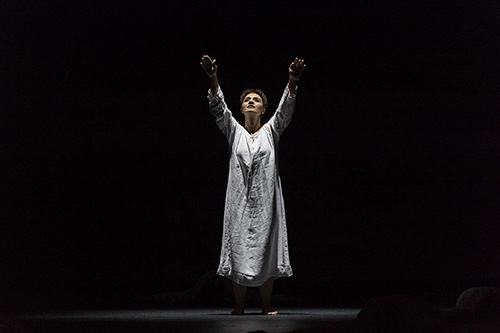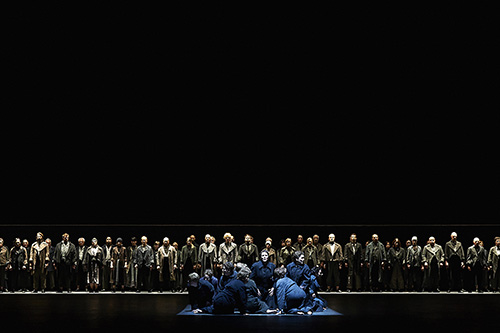-
A Dance Towards the Light: Robert Carsen and Michael Levine Discuss Dialogues des Carmélites
By Danielle D'OrnellasPosted in 2012/2013By Claire Morley, Communications Assistant

 Director Robert Carsen and set designer Michael Levine created their production of Poulenc’s Dialogues des Carmélites for the Netherlands Opera in 1997. Since then, it has been performed in numerous cities
across the world. Carrying “overwhelming emotional force” (Chicago Tribune), this is the first time their production of Carmélites will be seen in Toronto, an exciting venture for Carsen and Levine, both Toronto-born.
Director Robert Carsen and set designer Michael Levine created their production of Poulenc’s Dialogues des Carmélites for the Netherlands Opera in 1997. Since then, it has been performed in numerous cities
across the world. Carrying “overwhelming emotional force” (Chicago Tribune), this is the first time their production of Carmélites will be seen in Toronto, an exciting venture for Carsen and Levine, both Toronto-born.According to Carsen, the unique power of Dialogues des Carmélites lies in its ability to “speak to humanity in a very particular way. You don’t have to be Catholic to be moved by the sacrifice that these 16 Carmelite nuns made. It’s very powerful because of both the spiritual and intellectual quality of the work; these are people who have dedicated their whole lives to their beliefs, and achieve some kind of good through them.”
 Carsen and Levine, who have worked together for over 25 years on 26 productions, began their creative process by going directly to the score, paying careful attention to both Georges Bernanos’ libretto and Poulenc’s masterful setting, which Carsen argues is in a class of its own. “The quality of Poulenc’s writing is so beautiful and very seductive. The orchestration is brilliant, consisting of strange, electrifying moments, yet the whole work has a genuine and honest sincerity to it. It’s a very unusual piece of writing.”
Carsen and Levine, who have worked together for over 25 years on 26 productions, began their creative process by going directly to the score, paying careful attention to both Georges Bernanos’ libretto and Poulenc’s masterful setting, which Carsen argues is in a class of its own. “The quality of Poulenc’s writing is so beautiful and very seductive. The orchestration is brilliant, consisting of strange, electrifying moments, yet the whole work has a genuine and honest sincerity to it. It’s a very unusual piece of writing.”The musical climax of the piece is saved for the final scene, in which the nuns sing the famous “Salve Regina” and, one by one, are executed by guillotine until only Blanche is left singing, having finally accepted her faith. Intensely tragic though this ending may be, Carsen felt strongly that Poulenc’s score also evoked a sense of something more profound taking place. “The music is remarkable for this ending, and we wanted to try to find a way to deal with what we heard in it, which is both very powerful yet has a sense of something positive happening. You hear this in the music, which is so ravishingly beautiful. So we have treated this not just as a horror story with the guillotine, but in a more stylized way which I call a ‘dance towards the light."
Levine adds, “When Robert and I work, we always begin with the music and the story, and we try to find a way that will make it come alive for the audience. We take these pieces that were written anywhere from the 17th through to the 20th century and try to present them to an audience today in a way that is both accessible and exciting. That doesn’t necessarily mean turning it on its head and setting it in a Laundromat in Chinatown – it doesn’t have to be that. For us, it’s more about discovering the intention behind the piece.”
So much of this intention, Levine argues, is informed by the French Revolution. “We wanted to give the sense and feeling of what it would be like to be an aristocrat with revolution on the doorstep. That is a difficult story to tell and get across to an audience. Quite early, we decided the best way to illustrate that was to have a large group of revolutionaries on stage slowly close in. In order to give some sense of the anxiety within the piece, which is very apparent in the score, the revolutionaries slowly encroach on the aristocrats and nuns. We realized that the way to define these spaces was by using people.”

These various senses of space are some of the most powerful aspects of the production. Carsen says, “It’s really a space in which the audience has to believe. We use people, not objects, to delineate it, and I decided not to use any scenic elements that would describe where you are. I felt very strongly that it was wrong to have any theatricalized religious elements, so there are no crucifixes apart from on the rosary, and no religious scenery – it is all done in a much more abstract way. Religious scenic elements on the stage can very easily go kitsch on you, and I wanted to avoid that.
“I don’t think it’s possible to do it in a more minimalistic way, and I couldn’t think of the work as being anything other than an empty space – like the emptiness of a cell. If you think of a monk or a nun praying in a completely undecorated space, you can imagine this ‘faith space.’” Levine adds, “As soon as you bring an object into that space, it places great importance on that object. You can define it in other ways – we try to define the emotion of the scene in an empty space defined by the people on stage and the lighting.”
Carsen believes that these spaces will be complemented by the aesthetic of the Four Seasons Centre for the Performing Arts (FSC). “Apart from Amsterdam, we have never done this production in a really modern opera house,” he says, “and the FSC will be an incredible support to this production. Even the production’s colour tones are very much in harmony with the hall. And with one of the best casts we’ve ever had, I think it’s going to be very powerful to hear this in that theatre.”
Levine adds that he is particularly excited to bring it to Toronto because of his pride in the production. “It feels good to do something that, after 16 years, is still a very strong piece of work. That is very rare and I’m thrilled to see it finally make its way to Toronto, to one of the best newly designed opera houses in the world, and one that I really love.”
Carsen is similarly enthusiastic about bringing it to Toronto audiences. “I think wherever one performs it, it inevitably has an extraordinary impact; Poulenc’s personal circumstances while he was writing the work are very much in the DNA of this piece. You feel his personal suffering very poignantly in the opera. I really believe this is Poulenc’s masterpiece, and I can’t wait for everyone to rediscover it.”
This article is published in our spring house program. Click here to read the issue online.
Photos: (top) Isabel Bayrakdarian as Blanche de la Force in the Canadian Opera Company’s production of Dialogues des Carmélites, 2013.; (middle) Robert Carsen; (middle) Michael Levine; (bottom) A scene from the Canadian Opera Company’s production of Dialogues des Carmélites, 2013.. Photos by (top) Chris Hutcheson; (middle) Filip Sanguinetti; (middle) Michael Cooper; (bottom) Michael Cooper.
